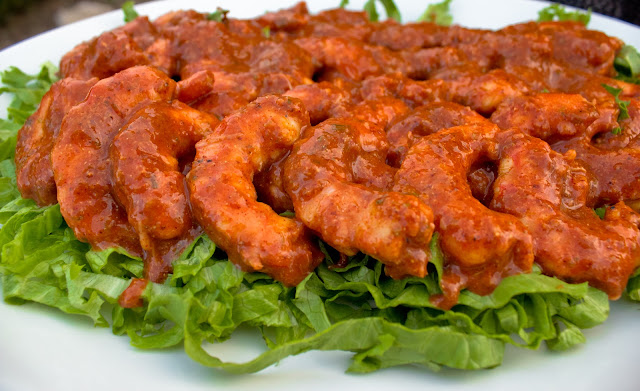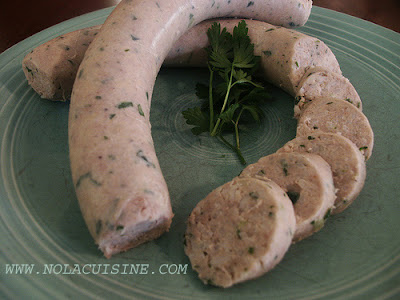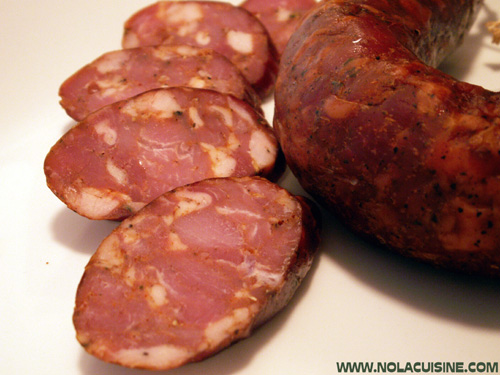 |
| From Nola Cuisine |
This one is for my buddy M.A. Sample over at The Wreckroom, I know it’s one of his favorites; his wife S.A. makes a mean Po’ Boy as well.
I am forever on a quest for a good New Orleans French Bread recipe or substitute, this bread was an okay stand-in to scratch that Po’ Boy itch, but it’s just not the same. As I’ve said in the past, when it comes to Po’ Boys, the bread is really the star of the show. This one wasn’t exact, but somewhat similar, soft on the inside and a nice crisp crust.
There are a few restaurants here in Michigan that could make a half-way decent Po’ Boy, if they just wouldn’t mess with it so much. One place uses Cole Slaw, another puts cocktail sauce on it!!?? Come on man, now you’re just being silly! No Remoulade sauce, no Chipotle mayonnaise, just a dressed Po’ Boy! You’re killing me!
I’ll bet if someone opened a straight up Po’ Boy shop in the right location here in Michigan, they would clean up! The restaurants that serve them here try to make it Gourmet, I just want to grab ’em and shake ’em! It’s called a Po’ Boy, knock it off already! Mayonnaise, Mustard, Shredded Lettuce, Pickles, sometimes Tomato, Filling, hot sauce on the table. Nothing fancy, and the messier the better.
I’ve been experimenting around recently with something I saw Mario Batali use. He used Wondra flour to fry some things, saying it gives a crispier final product. I have to say, I’m sold after the ultra- crispy Shrimp I just fried up. Wondra flour (Gold Medal brand) is found in the baking aisle, it’s what is known as an instant flour, produced to thicken sauces and gravies. You can use just plain old All Purpose flour in place of it in this recipe.
Here is my Fried Shrimp Po’ Boy recipe:
Fried Shrimp Po’ Boy Recipe
1 10-12″ long piece of New Orleans Style French Bread
4 Tbsp Mayonnaise
3 Tbsp Creole Mustard (Zatarain’s makes a good widely available Creole Mustard. I’m actually working on a recipe for Homemade Creole Mustard.)
Pickle Slices
3/4 Cup Shredded Lettuce
Tomato Slices (Optional)
Fried Shrimp for Filling (Recipe below)
Slice the bread in half horizontally, I also like to give it a minute or two in the oven to crisp up the crust.
Spread the Mayonnaise on the inside of the bottom portion of the bread, spread the Creole Mustard on the inside of the Top portion, and a layer of Mayonnaise on top of that. Spread you lettuce on the bottom portion of bread, then your pickles and Tomatoes (if using). Top with the Fried Shrimp, and put the lid on. Cut the Po’ Boy in half if desired.
Serve with an ice-cold Beer (like Dixie, Abita Amber, or your personal favorite) and kettle style Potato chips (like Zapp’s). Put some hot sauce on the table and enjoy.
**Note**I cracked into my remaining Dixie Beer stash for this sandwich, I have 12 left.
Makes 1 Sandwich
Fried Shrimp for a Po’ Boy
2 1/2 Cups Vegetable Oil for Frying
1/2 Cup Wondra Flour
Coating:
1/4 Cup Wondra Flour
1/2 Cup Corn Flour
2 Tbsp Creole Seasoning, in all
1 Egg
2 Tbsp Water
1/2 Pound Peeled & Deveined Medium Shrimp
Heat the oil to 360 degrees in a 2 qt. saucepan.
Season 1/2 Cup of the Wondra flour with 1 Tbsp Creole Seasoning in a bowl.
In another bowl, Mix the egg well with 2 Tbsp of water, and 1 tsp Creole Seasoning.
In another bowl, Mix the Corn flour, Wondra Flour and the remaining Creole Seasoning.
Dredge the shrimp in the seasoned flour, then the egg wash, then the corn/wondra flour mixture. Fry in batches in the 360 degree oil until just golden brown. Do not overcrowd the pan, and let the oil come back to temperature before frying another batch.
More Sandwich Recipes at Nola Cuisine:
Roast Beef Po’ Boy with Debris Gravy
The Muffuletta
More Seafood Recipes:
Oysters Bienville
Shrimp Remoulade
Related links:
Po’ Boy Pics at Egullet





